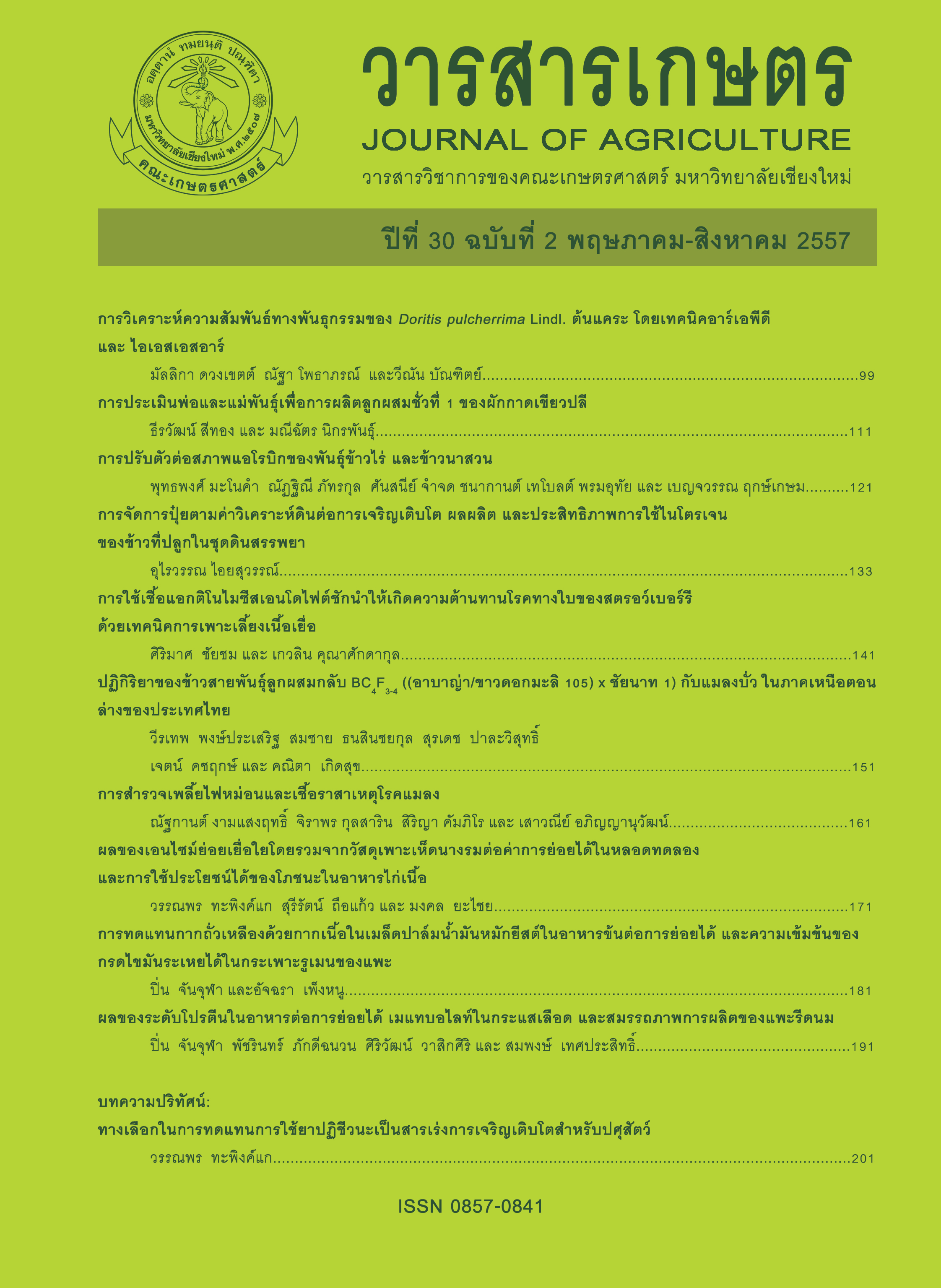การปรับตัวต่อสภาพแอโรบิกของ พันธุ์ข้าวไร่ และข้าวนาสวน
Main Article Content
บทคัดย่อ
ข้าวมีการปรับตัวของรากต่อสภาพแอโรบิกที่แตกต่างกันทั้งด้านการดูดน้ำและอาหาร ซึ่งการศึกษาระบบรากข้าวใช้เวลานานและลำบาก ดังนั้นการประเมินและคัดเลือกพันธุ์ที่มีการปรับตัวของรากจึงทำได้ยาก การศึกษานี้เริ่มจากเปรียบเทียบการเจริญของรากข้าว 2 พันธุ์คือ พันธุ์บือบ้าง (ข้าวไร่) และขาวดอกมะลิ 105 (ข้าวนาสวน) ในวัสดุปลูก 8 ชนิด ในงานทดลองที่ 1 เพื่อหาวัสดุปลูกที่เหมาะสมในการนำมาใช้ศึกษารากข้าวที่ง่ายและรวดเร็ว พบว่า ดินชุดสันทรายและดินดำเป็นวัสดุปลูกที่เหมาะสมในการศึกษาระบบรากข้าวการทดลองที่ 2 ศึกษาการปรับตัวต่อสภาพปลูกแอโรบิกเทียบกับสภาพน้ำขังพันธุ์ข้าวนาสวน 3 พันธุ์ และข้าวไร่ 3 พันธุ์ พบว่า ข้าวพันธุ์ บือบ้าง ชัยนาท 1 และ R 258 มีน้ำหนักรากเพิ่มขึ้นในสภาพแอโรบิก ส่วนการกระจายตัวของรากที่ความลึกใต้ผิวดิน 0-15 เซนติเมตร ข้าวนาสวนมีน้ำหนักรากลดลงยกเว้นพันธุ์ชัยนาท 1 ที่ความลึก 15-30 เซนติเมตร ข้าวไร่มีน้ำหนักรากเพิ่มขึ้นแต่ข้าวนาสวนลดลง และที่ความลึกมากกว่า 30 เซนติเมตร ข้าวทุกพันธุ์มีน้ำหนักรากเพิ่มขึ้น การเจริญทางลำต้นพบ น้ำหนักต้นและจำนวนหน่อของข้าวนาสวนเพิ่มขึ้น แต่ความสูงลดลง ส่วนข้าวไร่ไม่เปลี่ยนแปลง ทำให้ค่า root/shoot ratio ของข้าวไร่เพิ่มขึ้นในสภาพแอโรบิก แต่ในข้าวนาสวนลดลงยกเว้นพันธุ์ชัยนาท 1 สำหรับการสะสมธาตุอาหารไนโตรเจนพบเพียงพันธุ์ปทุมธานี 1 ที่มีค่าเพิ่มขึ้นในสภาพแอโรบิก ฟอสฟอรัสของข้าวไร่ส่วนใหญ่ลดลงและข้าวนาสวนไม่เปลี่ยนแปลง โพแทสเซียมมีเพียงปทุมธานี 1 เพิ่มขึ้นและสุพรรณบุรี 1 ลดลง แคลเซียมเพิ่มขึ้นในพันธุ์ชัยนาท 1 และพันธุ์บือบ้าง และการสะสมแมกนีเซียมพบว่ามีเพียงข้าวสุพรรณบุรี 1 เท่านั้นที่ลดลงในสภาพแอโรบิกในขณะที่พันธุ์อื่นไม่มีการเปลี่ยนแปลง
Article Details
References
ดิน..ของประเทศไทย (ออนไลน์). 2556. สืบค้นจาก: http://www.ldd.go.th/thaisoils_museum/INDEX.HTM (2 มกราคม2557).
เบญจวรรณ ฤกษ์เกษม. 2552. การปลูกข้าวประหยัดน้ำ ด้วยวิธีปลูกแบบแอโรบิก. นิตยสารเทคโนโลยีชาวบ้าน 20(423): 63-64.
สุวรรณี แลน้อย ศันสนีย์ จำจด และ เบญจวรรณ ฤกษ์เกษม. 2550. ความแตกต่างระหว่างพันธุ์ข้าวไทยในการปรับตัวต่อสภาพดินไม่ขังน้ำ. วารสารเกษตร 23(ฉบับพิเศษ): 19-24.
สำนักงานวิจัยและพัฒนาข้าว กรมการข้าว. 2556. องค์ความรู้เรื่องข้าว (ระบบออนไลน์). แหล่งที่มา http://www.ricethailand.co.th (24 เมษายน 2556).
สำนักงานเศรษฐกิจการเกษตร. 2555. ผลพยากรณ์เนื้อที่เพาะปลูกและผลผลิตข้าวไทย (ระบบออนไลน์). แหล่งที่มา: http://www.thairiceexporters. or.th/production.htm (25 เมษายน 2555).
Girdthai, T., S. Jogloy, T. Kesmala, N. Vorasoot, C. Akkasaeng, S. Wongkaew, C. C. Holbrook, and A. Patanothai. 2010. Relationship between root characteristic of peanut in hydroponic and pot. Crop Science 50: 159-167.
George, T., R. Magbanua, P. G. Dennis, S. Brenda, A. Tuban, and J. Quiton. 2002. Rice rapid yield loss of rice cropped successively in aerobic soil. Agronomy Journal 94: 981-989.
Insalud, N., R. W. Bell, T. D. Calmer and B. Rerkasem. 2006. Morphological and physiological responses of rice (Oryza sativa L.) to limited phosphorus supply in aerated and stagnant solution culture. Annals of Botany 98: 995-1004.
International Rice Research Institute (IRRI). 2005. Ann. Report. Los Banos, Philippines.
Kamoshita, A. R., N. Chandra Babub, B. Manikanda Boopathi and C. Shu Fukai. 2008. Phenotypic and genotypic analysis of drought-resistance traits for development of rice cultivars adapted to rainfed environments. Field Crops Research 109: 1-23.
Kato, Y., A. Kamoshita and J. Yamagishi. 2008. Pre-flowering abortion reduces spikelet number in upland rice (Oryza sativa L.) under water stress. Crop Science 48: 2389-2395.
Kundu, D. K. and J. K. Ladha. 1997. Effect of growing rice on nitrogen mineralization in flooded soil. Soil Science Society of America Journal 61: 839-845.
Lay Heng, S. 2010. Drought tolerance and nutrient uptake efficiency in maize. M. S. Thesis, Graduate School, Chiang Mai University, Thailand
Marschner, H., M. Treeby and V. Römheld. 1989. Mobilization of iron and other micronutrient ations from a calcareous soil by plant-borne, microbial, and synthetic metal chelators. Plant and soil 114: 217-226.
McDonald, A. E., B. R. Grant and W. C. Plaxton. 2001. Phosphite (phosphorous acid): Its relevance in the environment and agriculture, and influence on the plant phosphate starvation response. Journal of Plant Nutrition 24: 1505-1519.
Phattarakul, N. 2008. Genotypic variation in tolerance to soil in local upland rice varieties. Ph.D. Thesis, Graduate School, Chiang Mai University, Thailand.
Wang, H., B. A. M. Bouman, D. Zhao, C. Wang and P. F. Moya. 2004. Aerobic rice in northern China. pp. 143-154. in Water-wise rice production, International Rice Research Institute, Los Banos, The Philippines.
Zhang, H., Y. Xue, Z. Wang, J. Yang and J. Zhang. 2009. An alternate wetting and Moderate soil drying regime improves root and shoot growth in rice. Crop Science 49: 2246-2260.

